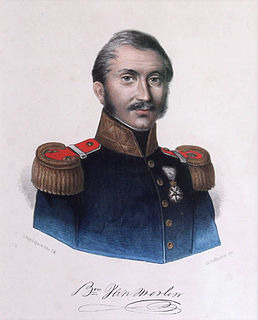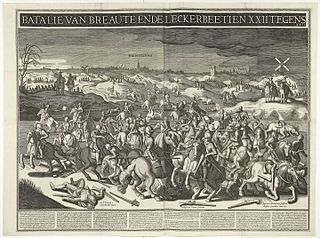
The Battle of Nieuwpoort, took place on 2 July 1600 during the Eighty Years War and the Anglo-Spanish war in the dunes near Nieuwpoort. The Anglo-Dutch companies met the Spanish veterans head on which although their left flank nearly broke were able to assail them with both infantry and cavalry. The Spanish gradually scattered in all directions and left their guns on the field.

The Battle of Turnhout also known as the Battle of Tielenheide was a military engagement which took place on 24 January 1597 in the border area between the Northern and Southern Netherlands at Turnhout during the Eighty Years' War and the Anglo-Spanish War (1585–1604).

Arnold Joost van Keppel, 1st Earl of Albemarle,, and lord of De Voorst in Guelders (Gelderland), was a Dutch military leader who fought for King William III of England and became the first Earl of Albemarle. He was the son of Oswald van Keppel and his wife Anna Geertruid van Lintelo. De Voorst is a large country house near Zutphen, financed by William III, and not unlike the royal palace Het Loo in Apeldoorn.

Sebastiaen Vrancx, Sebastiaan Vrancx or Sebastian Vranckx was a Flemish Baroque painter and draughtsman who is mainly known for his battle scenes, a genre that he pioneered in Netherlandish painting. He also created landscapes with mythological and allegorical scenes, scenes with robbers, village scenes and celebrations in cities. He was a gifted figure painter who was regularly invited to paint the staffage in compositions of fellow painters.

Jonkheer Albert Dominicus Trip van Zoudtlandt was a Dutch lieutenant-general of cavalry who headed the Dutch heavy cavalry brigade at the Battle of Waterloo.
Frederik van den Bergh was a soldier in the Eighty Years' War. His titles included Lord of Boxmeer.

The Dutch States Army was the army of the Dutch Republic. It was usually called this, because it was formally the army of the States-General of the Netherlands, the sovereign power of that federal republic. This mercenary army was brought to such a size and state of readiness that it was able to hold its own against the armies of the major European powers of the extended 17th century, Habsburg Spain and the France of Louis XIV, despite the fact that these powers possessed far larger military resources than the Republic. It played a major role in the Eighty Years' War and in the wars of the Grand Alliance with France after 1672.
The Battle of Lincelles was an action that took place as part of a larger manoeuvre on 17 August 1793 in the Flanders Campaign of the War of the First Coalition. It was fought between the forces of Revolutionary France under the command of Jean Baptiste Jourdan and Antoine Anne Lecourt de Béru, versus those of Great Britain under Frederick Augustus, Duke of York and Albany and the Dutch Republic under the Hereditary Prince of Orange. The action resulted in a coalition victory.

The Battle of the Lippe was a cavalry action fought on 2 September 1595 on the banks of the Lippe river, in Germany, between a corps of Spanish cavalry led by Juan de Córdoba and a corps of Dutch cavalry, supported by English troops, led by Philip of Nassau. The Dutch statholder Maurice of Nassau, taking advantage of the fact that the bulk of the Spanish army was busied in operations in France, besieged the town of Groenlo in Gelderland, but the elderly governor of the citadel of Antwerp, Cristóbal de Mondragón, organized a relief army and forced Maurice to lift the siege. Mondragón next moved to Wesel, positioning his troops on the southern bank of the Lippe river to cover Rheinberg from a Dutch attack. Maurice aimed then, relying on his superior army, to entice Mondragón into a pitched battle, planning to use an ambush to draw the Spanish army into a trap. However, the plan was discovered by the Spanish commander, who organized a counter-ambush.

The Battle of Noordhorn, fought on 30 September 1581, was a pitched battle of the Dutch Revolt, fought between a Spanish army commanded by Colonel Francisco Verdugo – consisting of Walloon, German, Spanish, and Albanian soldiers – and a Dutch States rebel army under the Englishman John Norreys – comprising English, Scottish, Dutch, and Walloon troops – in the province of Groningen. In 1580, the Dutch stadtholder of Groningen, George van Lalaing, Count of Rennenberg, had shifted its allegiance from the Dutch to the Spanish side. This opened a new front at the back door of the Dutch Republic, forcing the States-General to dispatch forces to the north. That year the Dutch, under the leadership of John Norreys, succeeded in relieving the town of Steenwijk. In July 1581, Rennenberg died and was replaced by the Spaniard Francisco Verdugo, whose arrival in Groningen with reinforcements changed the situation. On 30 September Verdugo forced Norreys to give battle using a strategy of attrition.

The Siege of Eindhoven, also known as the Capture of Eindhoven of 1583, took place between 7 February and 23 April 1583 at Eindhoven, Duchy of Brabant, Spanish Netherlands during the Eighty Years' War and the Anglo-Spanish War (1585–1604). On 7 February 1583 a Spanish force sent by Don Alexander Farnese, Governor-General of the Spanish Netherlands, commanded by Karl von Mansfeld and Claude de Berlaymont, laid siege to Eindhoven, an important and strategic city of Brabant held by Dutch, Scottish, and French soldiers under the States' commander Hendrik van Bonnivet. After three months of siege, and the failed attempts by the States-General to assist Bonnivet's forces, the defenders surrendered to the Spaniards on 23 April.
Jean Marie Antoine Philippe de Collaert led the Dutch-Belgian cavalry division at the Battle of Waterloo. He became an officer in the Habsburg Austrian cavalry in 1778 and later served in the Dutch Republic army until 1786. After the armies of the First French Republic overran the Dutch Republic in 1795, Collaert became a lieutenant colonel of hussars in the new army of the Batavian Republic, a French satellite state. He fought with distinction at the Battle of Castricum in 1799 and was badly wounded fighting the Austrians in 1800. He was promoted colonel in 1803. Under the Kingdom of Holland he became a major general in 1806 and colonel-general of the King's Bodyguard in 1808.

Major General Jean Baptiste Baron van Merlen was a Dutch-Belgian army officer who, following the varied fortunes of his homeland, fought on both sides during the French Revolutionary and Napoleonic Wars. Fighting in a series of campaigns in the Netherlands, Germany and Spain, he played an important part in the battles of Quatre Bras and Waterloo, where he was killed in action.

Antonie Frederik Jan Floris Jacob Baron van Omphal was a Dutch lieutenant-general and extraordinary aide-de-camp to William III of the Netherlands. He was awarded a knighthood in the Military William Order among other honours.

The Battle of Lekkerbeetje or Lekkerbeetken was a cavalry duel fought by pre-arrangement on Vughterheide near 's-Hertogenbosch, North Brabant, between 22 Brabantine cavalrymen loyal to Albert VII, Archduke of Austria, garrisoned in 's-Hertogenbosch, and 22 French cavalrymen serving in the army of the Dutch Republic.

Piere de Bréauté, lord of Bréauté (1580–1600) was a nobleman from Normandy who died at the age of 19 as a cavalry captain in the service of the Dutch Republic, in a cavalry duel known as the Battle of Lekkerbeetje.
Ernst Christoph von Nassau, sometimes called Christoph Ernst, was a Prussian general lieutenant and knight of the Black Eagle Order. He is memorialized on the Equestrian statue of Frederick the Great. After fighting in the Prussian army during the War of Spanish Succession, he transferred to the Hessian army; subsequently, he served during peacetime in the army of the Duke of Saxony and in 1740, upon the ascension of Frederick in 1740, he rejoined the Prussian army and served in the War of Austrian Succession.

The siege of San Andreas also known as the siege of Sint-Andries was a military event that took place during the Eighty Years' War and the Anglo–Spanish War from 28 January to 6 March 1600. The Spanish garrison of San Andreas was besieged by an Anglo-Dutch force led by Maurice of Nassau. A Spanish relief force under the command of Luis de Velasco failed to relieve the fort after having been turned back by the besiegers. The fort surrendered after the garrison mutinied and accepted payment from Maurice.

Fort Crèvecoeur was a Dutch fortress near 's-Hertogenbosch. It is now a military exercise terrain.
The Luxemburg campaigns were two military campaigns by the Dutch Republic and the Duchy of Bouillon against the Spanish Southern Netherlands during the Eighty Years' War in 1593 and 1595. The first was undertaken by a Dutch States Army commanded by Philip of Nassau to the Duchy of Luxemburg in early 1593, with the aim of distracting the Spanish Army of Flanders to a different part of the Habsburg Netherlands, create confusion and block the importation of new pro-Spanish troops to the Low Countries via the Spanish Road. Other goals were dealing economic damage to Spain, and supporting the Protestant claimant to the French throne Henry of Navarre and the Protestant prince of Sedan and duke of Bouillon, Henry de La Tour d'Auvergne.














